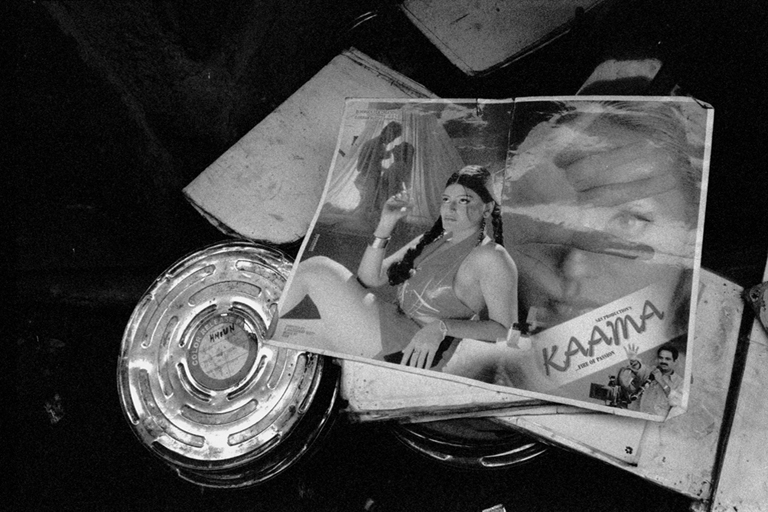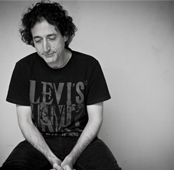-
 Can Coolie (c) Shahid Datawala
Can Coolie (c) Shahid Datawala -
 Can Roller (c) Shahid Datawala
Can Roller (c) Shahid Datawala -
 Can Seduction (c) Shahid Datawala
Can Seduction (c) Shahid Datawala -
 Cans and Feet (c) Shahid Datawala
Cans and Feet (c) Shahid Datawala -
 Cans and Feet (c) Shahid Datawala
Cans and Feet (c) Shahid Datawala -
 Film Checker (c) Shahid Datawala
Film Checker (c) Shahid Datawala -
 Kaama (c) Shahid Datawala
Kaama (c) Shahid Datawala -
 Resting Cans (c) Shahid Datawala
Resting Cans (c) Shahid Datawala
As part of his project Dress Circle, between 2003-2005 Shahid Datawala began exploring the business of B and C grade films in the Chandni Chowk area of Old Delhi where most of the small time distributors had their offices. They worked within the area— transporting film from Chandni Chowk to Paharganj and Dai Wara and other surrounding neighborhoods. Films were transported in cans by coolies from one distributor’s office to another or to the theatres.
He began photographing this peculiar mode of film distribution.
He was intrigued by how a movie in its physical state was dealt with. He cringed when he saw how the cans were strewn on the streets or used as makeshift stools as these men went about their work. “They were opening the cans to check the film,” he says. “They were manhandling it. It wasn’t like: we have to wear gloves, make sure there’s no oil on our hands, that the film isn’t scratched. That’s why you see so many scratches on screen sometimes.” There was no respect in the way they handled it. It was like: “Film Ko Nikalo, Usko Ghumao Daalo, Andar Can Mein Fit Karo, Jaakey Deo (Take the film out, turn it around, fit it in the can, and deliver it).”
Datawala believes in keeping a distance from his subjects which limits his interaction with them. He believes in experiencing the equation with his subjects on his own terms, and not getting manipulated by inputs the subjects would provide him, or not. He even eschews the term ‘photographer’ with its documentary connotations and prefers to call himself a ‘lens-based artist’ instead. He was not out to document the Can Coolies, he says. His interest in their work was purely visual and aesthetic. As a result he can only speculate that they were paid about Rs 80, 100 or 150 on a daily basis, depending on how much film was to be carried. And that they possibly got a little extra if they had to hire a rickshaw. He doesn’t know where they are from or what they make of their job.
The coolies themselves found Datawala’s interest in them strange. The soft porn distributors were suspicious too. “They probably thought I was taking pictures of the area to gather evidence for the police, or maybe they thought I was a terrorist.” He recalls a visit to one of their offices. “They were Punjabi men, sitting at desks with posters of nude, semi-nude women on the walls next to pictures of deities”, he says. “I had a tough time trying to convince them that I wasn’t going to blow the place up.”
Datawala sees his work on the ‘Can Coolies’, as he calls them, as an extension of his work on old cinema halls in Delhi. Once upon a time these halls had been majestic in their glory but fell into disuse over time, and now screen B grade movies to survive. The damage and degeneration of the film during its transportation by the coolies mirrored the degeneration of the cinema halls Datawala was photographing. Both were symbols of the passing of an era. He mourns the loss of these places but accepts it as an inevitable rite of the passage of time.
His own affinity to the past, however, is evident in more than his choice of subjects. Datawala has shot the Can Coolies on a film camera. Despite digital cameras nearly obliterating film, Datawala has only taken to shooting digital in the last five years. He still prefers film, for technical and aesthetic reasons. “Film has more soul”, he says.
Text by Alyssa Lobo
Can Coolies
Photo EssayOctober 2012
 By Shahid Datawala
By Shahid Datawala
For over 20 yearsShahid Datawala’s multidisciplinary practice has seen him segue sure- footedly across media and creative expression. Within the broad ambit of his design and lens- based practice Datawala has worked with photography, video, furniture, jewellery and fashion among other spheres. Datawala’s photography has been exhibited in several solo and group shows in India and abroad. An award-winning furniture designer, he is the chief designer for Pallate, a furniture and design store in Bombay. Datawala lives and works in Bombay.




















